Lore Turned Upside Down
Amidst attempts by the regeneration industry to give areas cultural kudos by resurrecting their orthodox histories, last October’s Bristol Radical History Week re-activated some of the city’s unrulier historical episodes - ones that trouble the (interlinked) processes of historicisation and regeneration. Report by Roger Wilson and C. Heatherton
If you happened to be shopping at the stalls of Bristol’s historic Corn Street a drizzly grey Saturday last October, you would have heard the drums. Thundering off the cobblestones and punctuated by the steady march of soldiers’ boots, they announced the arrival of a strange procession. Silhouettes of pikes and muskets bobbed through the damp haze. Women cried ‘Holy, Holy, Holy’, ‘Hosanna!’, ‘Prince of Peace!’. Willow boughs whipped through the air. Feathers and sequins from can-can costumes fluttered to the ground. Coming into view at the head of this chaotic flurry, was an unassuming young man in drab clothes nobly riding a papier-mâché donkey.
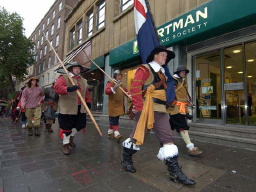
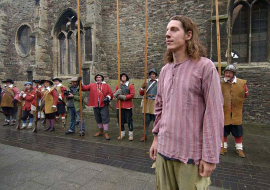
Images: all photos by Simon Chapman
The Bristol Radical History Week began with a commemoration of James Nayler’s infamous ride into Bristol 350 years ago. In October 1656, Nayler, a radical preacher, democrat, religious leveller, soldier in Cromwell’s New Model Army and possibly the most powerful orator of the nascent Quaker movement, scandalously provoked authorities with a ‘blasphemous’ ride into Bristol. Riding a donkey, escorted by a throng of ranting women who proclaimed him ‘The Prince of Peace’ and laid palm leaves at his feet, Nayler boldly imitated Christ’s entrance into Jerusalem on Palm Sunday. This symbolic act of ‘levelling’ represented the belief that ordinary men and women could achieve the perfection of Christ without the oppressive mediation of a religious structure. After orchestrating one of the most effective publicity stunts in history, Nayler was publicly tortured, ridiculed, and subsequently written out of history.

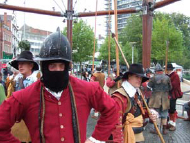
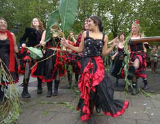
The anniversary of Nayler’s forgotten ride was reproduced with an authentically outfitted regiment of the New Model Army, a rowdy troupe of can-can dancers, a long-haired young Nayler, a papier-mâché donkey and one surprised crowd. This historical re-enactment fittingly inaugurated a week of events devoted to uncovering some of Bristol’s hidden and misrepresented history.
Bristol Radical History Week was initially conceived many months ago among an informal reading group to commemorate both the 350th anniversary of Nayler’s ride into Bristol and the 175th anniversary of the Queen Square riots sparked by the defeat of the Reform Act of 1831. It blossomed into 30 events over nine days last October and November, including public lectures and debates, a film festival, several gigs and an exhibition. The objective of the event was to engage academics, local historians and the general public in a process of examining some major historical events in Bristol’s past. In addition organisers wanted to approach this history from ‘below’, to examine the actions of the crowd, dissenters and radicals as the ‘subject’ of history. Unaffiliated with any universities, institutions, or political parties, the organisers’ additional aim was to demonstrate a popular reclamation and celebration of this history.
1831 and all that….
One of the objectives of Bristol Radical History Week was to re-examine some of the momentous events of Bristol’s history that have been often dismissed by historians as ‘chaos’ or ‘inexplicable’. The process of this examination by academics, local historians and interested punters during the week exposed some of the key problems of historical analysis.
The three days of rioting that occurred in October 1831 in Bristol were certainly a case in point. The events are usually portrayed as the actions of a drunken and debauched mob acting without plan or reason, put down with necessary violence by the authorities and resulting in an undisclosed number of casualties. There is considerable written evidence describing the ‘horrific’ events from the point of view of the local media and ruling class, but apart from the dubious legitimacy of court case records (where four supposed ‘rioters’ were hanged and 88 transported or imprisoned), there are no accounts from the rioters.
1831 was a period of significant unrest in Britain centred in the political arena around issues of parliamentary reform and the abolition of slavery.[1] In France in 1830 suffrage issues had caused a revolution that had brought people to the barricades and forced the King to abdicate. The warning signs were there for the corrupt and tiny minority that controlled political power in Britain. As a pacifying gesture, a bill that would extend suffrage to a small section of the middle class was introduced and then defeated in the House of Lords in September of that year. Public anger was widespread, there were riots in the Midlands against anti-reform aristocrats, the effigies of Bishops who were against reform were burned and there was widespread sabotage in factories and mines.
In Bristol the magistrate, Sir Charles Weatherall, a notorious opponent of reform arrived in the city to open the hated assizes and decided to celebrate the defeat of the Reform Bill with the Bishop and other notaries.[2] A protest by pro-reformists was joined by an angry mob who then attacked the Mansion House where Weatherall tried to take shelter after his carriage was stoned. After a cavalry charge by the Light Dragoons cleared the crowd from Queen Square, the wealthy merchants who made up the notoriously corrupt Bristol Corporation must have thought the unrest was over. How wrong they were! The next day the mob returned with greater numbers and with a determination to burn, loot and destroy those institutions that they despised, the prisons, the houses of the rich and the edifices of the corrupt (the Bishop’s Palace, the Cathedral). Some middle class pro-reformists attempted to halt the actions of the crowd by trying to convince them that Weatherall had left the city and, in so doing, revealed how little they understood the rioters. This wasn’t about parliamentary reform any more, this was an explosion of class anger expressed in a characteristically Bristolian party of looting, drinking and destruction![3]
It is ironic that to this very day the crowd are misunderstood by academics, just as they were misunderstood by the pro-reform middle classes of the time. Staring us in the face is the indisputable evidence of the systematic destruction of selected targets. Yet because the rioters did not leave memoirs or convenient minutes of their meetings (sic), they are cast as lacking agency and purpose by many historians. This problem was encountered several times during the analysis of 1831 and comparable events during the history week, as academics explained that they had vainly searched for evidence of pre-meditation, the involvement of ‘political clubs’, in fact anything that they would regard as physical evidence. The problem of course is that the class of people who probably took part in the rioting were mostly illiterate, were completely excluded from conventional politics and had no interest in telling the truth to the authorities (or to historians for that matter) as it may have got them executed, imprisoned or transported. They did of course leave physical evidence in the gutted prisons and burned houses of the wealthy rulers of Bristol, something which many revisionist historians have found an uncomfortable but indisputable fact ever since.
 Image: The ‘free party’ gets under way in Queen Square on the night of October 30th Bristol 1831 (W. J. Muller: Bristol City Museum and Art gallery)
Image: The ‘free party’ gets under way in Queen Square on the night of October 30th Bristol 1831 (W. J. Muller: Bristol City Museum and Art gallery)
And the left?
As was pointed out by Tristram Hunt recently in the Guardian in a series of articles looking at the most ‘over looked moments in British radical history’, the 1831 riots in Bristol have not entered the left wing/liberal ‘hall of fame’.[4] In my opinion, there are some key reasons for this. In 1819, 12 years before the events in Bristol, in Manchester at Peter’s Field or ‘Peterloo’, a massacre of reform protesters occurred. This event is well known, extensively researched and commemorated. All the boxes are ticked. The protesters at Peterloo had a clearly defined political aim within the context of parliamentary reform, they were organised in a conventional manner and were peaceful. In contrast, the crowd in Bristol went violently on the offensive, they were not organised in a manner that was understood by the left (to this day I would argue) and had clearly broken out of the confines of conventional politics. The Bristol crowd had a historical antecedent – the Bristol weavers and Kingswood colliers of the 18th century – who used riot as a weapon for price control and wage demands. This was their political heritage and it comes into conflict with what was and is generally understood as ‘radicalism’.
Consider the following excerpt from a larger piece considering whether Bristol had a ‘radical’ past, written for the 2006 Bristol ‘Festival of Ideas’ – a civic event attempting to rejuvenate the city as a centre of intellectual activity:
The question of whether Bristol actually had a radical past or not is an interesting one – a number of historians have suggested that it didn't. You could say that its failure to produce a strong corresponding society (to lobby for parliamentary reform) at the time of the French Revolution, its failure to maintain a strong and influential Chartist movement in the 1840s, and the propensity shown by its own working class to riot and burn the place down in 1831 rather than organise for reform more progressively, only reinforce the argument[5]
This piece is interesting as it exposes some of the criteria that are laid down by much of the academic community on what constitutes ‘radical action’. Firstly it has to be ‘organised’ in a manner that is understood by historians. As I have touched on earlier this would mean a formalised ‘political’ organisation with documentation, a constitution and a recognised platform. The riotous 1831 crowd in Bristol clearly operated on a completely different basis but this does not mean they were not organised. Their organisation would be far more analogous to a ‘network’ constituted around social ties from the factory, the pub and the street than the smoky rooms of the political club.[6]
This creates significant problems for an analysis based upon empirical evidence. How do we analyse a network based upon informal ties outside of clearly defined institutions? As an example of such an informal network, it was pointed out to a slightly incredulous audience at Bristol Radical History Week that the organisers of the event, the ‘Bristol Radical History Group’, did not exist (in the sense of being a clearly defined formal organisation concerned with history). Instead the ‘network’ of people across the city who organised the events were related more by connections to a sports club than to any local history group or academic institution![7] An empirical analysis by future historians, following the logic of connection by formal organisation, would probably come to the completely wrong conclusion that the Bristol Radical History Week was organised by the Regional History Centre at the University of West of England rather than a bunch of footballers. I give this example as it exposes the problems of method and the a priori assumptions of what constitutes ‘organisation’ within conventional historical analysis.
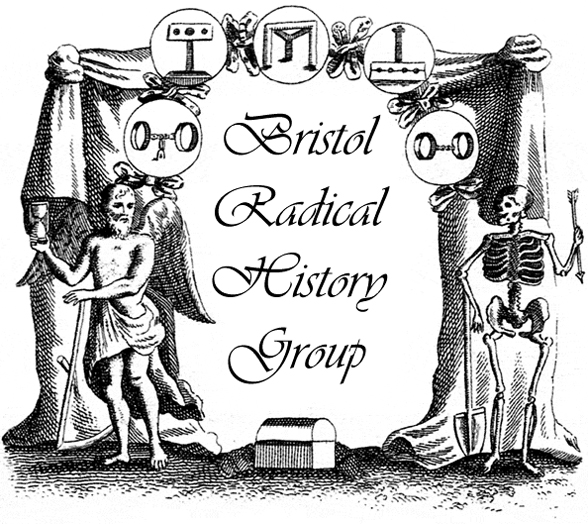
Revolution?
Returning to the Festival of Ideas’ critique of Bristol’s radical past: ‘You could say’, the article continues, ‘that its failure to produce a strong corresponding society (to lobby for parliamentary reform) at the time of the French Revolution… only reinforce the argument [of its non radical past]’ There are some massive ironies here. Clearly the French revolution was not principally carried out by people ‘lobbying for reform’, so why should progressive action in Britain only be understood in these terms? In fact it was the action of the ‘Parisian mob’ (or as we might say, informal networks of ‘sans-culottes’) that pushed a potential political compromise with the monarchy into a full-blown revolution between 1789 and 1792. After all who actually stormed the Bastille? Was it just the inhabitants of political clubs? The riotous crowd of 1831 in Bristol may have more direct connection with the ‘sans-culottes’ of Paris than is at first obvious.[8] They certainly had their own agenda to fulfil which clearly extended a lot further than a protest for the enfranchisement of a few middle-class people.
The debate over whether the 1831 riot was in fact a political protest has tended to polarise between revisionists, who want to portray it as motiveless criminal chaos, and romantic liberals who see the crowd as intensely political within the context of the politics of the reform of parliament. Neither of these seems particularly satisfactory for several reasons. As we have already pointed out, if it was just chaos why were the targets so selectively chosen and the mob able to traverse the city en masse to despatch them? Why were there targeted attacks on opponents of the Reform Bill? If it was just a protest about parliamentary reform why were the prisons targeted and wealthy houses looted? Why didn’t the rioters leave peacefully once they had driven the reactionary magistrate Weatherall out of the city?
As has been shown by historians such as Georges Rudé and Peter Linebaugh in their analysis of the ostensibly reactionary anti-catholic Gordon riots of 1780, all is not what it might seem.[9] The political spark of a riot may be ‘progressive’ or even ‘reactionary’ but the actions thereby unleashed may reveal a deeper agenda that escapes the conventional political realm. The 1831 rioters have left evidence of their agenda and we should concentrate on this rather than trying to fit it into crude theories of ‘criminality’ or ‘acceptable protest’. The physical evidence is that their targets were the wealthy members of the corporation who undemocratically ruled the city, the religious hierarchy and the prisons that had probably incarcerated many of them. They enjoyed a debauched party of looting, drinking and wanton destruction. They exercised power over the streets and squares of the wealthy elite. Far from being terrified victims of the military assault unleashed on them on the third day, they attempted to fight back and resistance continued throughout the city. This is what has to be examined. It may have been an ‘unacceptable protest’ within the confines of the politics of the day (or today) but that does not mean it was not political.
In fact, there is significant evidence that the violent unrest around the country and particularly in Bristol had a major effect upon the success of the 1832 Reform Bill. The undemocratic elite had both the weight of public opinion and the threat of at best riot and at worst revolution from the completely disenfranchised working class to contend with. So perhaps for Bristol ‘the propensity shown by its own working class to riot and burn the place down in 1831 rather than organise for reform more progressively’ is actually a happy error. The Bristol working class of 1831with its own riotous agenda may have had a far greater impact upon the rise of democracy in Britain than the staid talking shops of the middle-class reform clubs.
And today?
The countrywide Poll tax riots of 1990 and recent urban rioting in France confront us with similar problems of understanding the form and praxis of movements that defy formal organisational models. The way historians have dealt with moments like 1831 has direct parallels with the understanding of such contemporary events. Normally characterised in the media as ‘chaotic’ and or ‘criminal’ activity and often ignored by politicians as apolitical actions, these events nevertheless have had significant impact on the political landscape. As a result, such events attain a kind of magical quality, as there is no organisational or historical model to adequately define them. Why is it that organic networks refuse definition by both historians and political commentators?
While analyses of the networks that underlay the 1831 events can be superficially written off by the lack of ‘empirical evidence’, these contemporary events pose more problems as participants are alive and often members of our communities. The existence of contemporary witnesses and participants provides us with both a resource for understanding these networks, and potentially, a window into similar forms of organisation in the past.
[1] Less than 5% of the adult male population had the vote.
[2] ‘The Courts of Assize, or Assizes, were periodic criminal courts held around England and Wales until 1972 .... . The Assizes heard the most serious cases ... while the more minor offences were dealt with summarily by Justices of the Peace in petty sessions (also known as Magistrates' Courts).’ From Wikipedia, http://en.wikipedia.org/wiki/Assizes
[3] In any case, the Reform Bill would not have enfranchised the vast majority of the rioters. Ironically some revisionist historians have tried to reduce the events in Bristol to the inexplicable or the criminal arguing that the city actually had one of the highest proportions of the enfranchised in the country and that people did not have a reason to riot!
[4] The Guardian, 21-08-06
[5] Dr Steve Poole, ‘Radicals and Reformers’, 2006, http://www.ideasfestival.co.uk/radical.html. Poole is the Principal Lecturer in Social and Cultural History at the University of West of England
[6] A significant story from 1831 concerns the ‘borrowing’ of a large number of sledgehammers from Acraman’s Iron Foundry in Bathurst Basin (now Bristol General Hospital) the night before the events. These hammers were used during the riots to break down the doors of the four prisons in Bristol. The day after the riots, all but two of these hammers were returned. This fact, at the time, was used as evidence of premeditation by the ‘mob’.
[7] See www.brh.org.uk for more details of the collusion of a network of artists, punks, cricketers, footballers, can-can dancers, Civil War recreationists and academics leading to the Bristol Radical History Week.
[8] Interestingly, rioters covered the statue of William III in Queen Square with the French tricolore (the ‘Cap of Liberty’) causing real fears of a French revolution amongst government commentators of the time.
[9] George Rudé’s ‘The Gordon Riots: A Study of the Rioters and Their Victims’ in Paris and London in the 18th Century: Studies in Popular Protest, Fontana Library, 1970, and Peter Linebaugh’s The London Hanged, Verso, 2003, chapter 10.
Mute Books Orders
For Mute Books distribution contact Anagram Books
contact@anagrambooks.com
For online purchases visit anagrambooks.com






